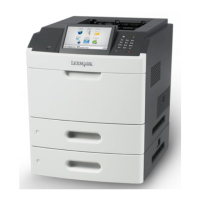Lexmark MS71x/MS81x & MX71x/MX81x Product Study Guide Rev 1.3
For Training Purposes Only 11/19/2012
Theory of Operation
Electrophotographic (EP) Process
The developed image in the printer is transferred directly to the print medium. A roller carries the medium
from the paper sources at the machine bottom, against the EP cartridges, and up to the fuser at the
machine top. The transfer rolls are biased with high voltages to attract the toner to the print medium. The
transfer applies an adequate charge to the medium to provide an electrostatic charge hold down force
that holds the medium in a fixed location on the belt. A cleaning blade with a backup roll scrapes toner
from the transport belt into a waste sump. Critical parameters for the EP process are the resistivity of the
transfer roll coat and the normal force against the photoconductive drum. The drive roll diameter is set
such that one drive revolution moves the transport belt the distance between transfer rolls for improved
image registration.
The list of the main component of the EP process is described below.
During the charge step, voltage is sent from the HVPS to the charge roll beside the
photoconductor. The charge roll applies a uniform negative charge over the entire
surface of the photoconductor to prepare it for the laser beam.
The laser fires a focused beam of light at the surface of the photoconductor and writes
an invisible image, called a latent image. The laser beam only discharges the surface
where the beam hits the photoconductor. This creates a difference in charge potential
between the exposed area and the rest of the photoconductor surface.
Once the laser exposes the photoconductor, the HVPS sends charge to the developer
roll. Because of the charge difference between the toner on the developer roller and
the electrostatic image created by the laser, the toner is attracted to areas of the
photoconductor surface exposed by the laser.
As the paper travels between the transfer roll and the photoconductor, the transfer roll
applies a positive charge to the back of the media. This positive charge attracts the
negatively charged toner image from the photoconductor to the top surface of the
media.
The paper – now with a “toned” image – moves through the fuser assembly. Using
temperature and pressure, it marries toner to paper.
The cleaning blade removes any toner that remains on the photoconductor after the
transfer process. The toner removed is collected in the imaging unit.
If a component fails, it is important to recognize at which step the failure took place. By knowing this, you
can determine the source of the problem. Understanding the EP Process is the key to troubleshooting
print quality problems.

